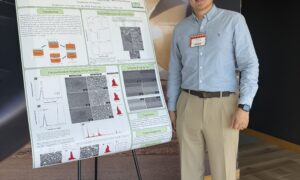A remarkable scientific breakthrough was unveiled at GeoDays 2025 in Oulu this March, as Rasheedah Fola Abioye, a master’s researcher at the Oulu Mining School, University of Oulu, alongside her thesis supervisor Professor Shenghong Yang and an international team of geoscientists, presented findings that could redefine how Europe sources its critical minerals. Their study, titled “Mineralogy and Geochemistry of the Terrafame Black Shale, and Its Implication of Hosting Minerals of Rare Earth Elements and Their Source,” offers the first detailed insight into the mineralogical makeup of Finland’s Terrafame black shale and its potential to host rare earth elements (REEs), materials vital to modern technology and green energy.
The research marks a significant step forward for the European Union’s resource independence, shedding light on an unconventional and previously underestimated source of REEs within a formation better known for its nickel, copper, cobalt, and zinc deposits. The findings were met with widespread interest from both academic and industry audiences at GeoDays, one of Northern Europe’s leading conferences on geoscience and mining innovation.
A Rare Glimpse into an Unusual Resource
The Terrafame deposit, located in Eastern Finland, is the largest black shale–hosted Ni–Cu–Co–Zn deposit in Western Europe. For years, it has been a cornerstone of Finland’s mining economy, supplying essential metals for batteries, renewable energy systems, and industrial production. Yet, until now, its potential role as a rare earth element reservoir has remained largely unexplored.
Abioye’s research brought this hidden potential to light. By applying a suite of advanced petrographic and geochemical techniques including Field Emission Scanning Electron Microscopy (FE-SEM), Electron Probe Microanalysis (EPMA), and Laser Ablation Inductively Coupled Plasma Mass Spectrometry (LA-ICP-MS) the team identified a suite of REE-bearing minerals within the black shale that had not been systematically characterized before.
Their detailed analysis revealed that minerals such as apatite, titanite, allanite, xenotime, and monazite, although present only in trace amounts (often less than 0.1%), play a disproportionately large role in hosting REEs within the rock. These findings challenge long-standing assumptions that black shales lack economic concentration of these elements, and it opens new possibilities for extracting critical materials from deposits already under active mining operations.
Unlocking the REE Puzzle
The study identified two distinct groups of apatite minerals, each with unique geochemical patterns that reflect different geological histories. One group displayed depletion in both light and heavy rare earth elements, coupled with a negative europium anomaly — a telltale sign of complex magmatic and post-depositional processes. The other group exhibited lower concentrations of heavy rare earths, indicating varying crystal chemistry or formation conditions within the deposit.
Similarly, allanite and titanite emerged as key contributors to the rare earth budget. Allanite was found to be strongly enriched in light rare earth elements, while titanite displayed higher levels of heavy rare earth and a negative europium anomaly, pointing to an igneous origin. These distinctions are crucial for understanding not only how the minerals were formed but also how they might behave during beneficiation and extraction processes.
Perhaps the most striking discovery was the presence of xenotime and monazite minerals typically associated with specialized igneous or metamorphic rocks rather than black shale environments. Though extremely rare within the samples, their contribution to the overall REE content is significant due to their exceptionally high concentrations of rare earths. This finding positions the Terrafame black shale as an unexpected repository of strategic materials, challenging conventional geological models.
Implications for Europe’s Resource Security
The implications of this discovery extend beyond academic curiosity. As Europe intensifies its search for domestic sources of critical raw materials essential to clean technologies including electric vehicles, wind turbines, and electronics the Terrafame deposit could play a pivotal role.
If further validated, the presence of REE-bearing minerals in black shales could reduce dependence on imports from Asia and contribute to the European Union’s Critical Raw Materials Act, which emphasizes sustainable and diversified sourcing of essential minerals.
Abioye’s presentation at GeoDays 2025 underscored how existing mining operations could potentially recover rare earths as by-products from ores already being processed for base metals. This approach could make extraction more sustainable and economically viable by minimizing the need for new mining infrastructure while enhancing the value chain of ongoing projects.
A Collaborative Scientific Milestone
The study exemplifies international collaboration at its best. Alongside Abioye and Prof. Yang, the author team includes M. Naveiras of Palsatech Global (Sweden), K. Kärenlampi and H. Brien of the Geological Survey of Finland, and M. Moilanen, J. Jokelainen, and D. Garcia-Balbuena of Terrafame Oy. Their joint expertise spans mineralogy, geochemistry, environmental geology, and mining engineering, an interdisciplinary approach essential for solving complex resource challenges.
The group’s integration of industrial and academic perspectives reflects a broader trend in geoscience: the merging of traditional mineral exploration with advanced analytical science and environmental responsibility. Terrafame Oy’s involvement provided real-world context and access to authentic geological materials, while the University of Oulu’s Mining School contributed analytical precision and scientific depth.
A Breakthrough for Black Shale Research
Despite extensive studies of black shales for their economic and environmental importance, research has often focused on their metal content rather than their potential for rare earth enrichment. The Oulu team’s work challenges that imbalance, providing the first comprehensive assessment of the REE-hosting potential of these rocks in Finland.
By quantifying the relative contributions of each mineral type to the total REE budget, the team demonstrated that even trace minerals, when accurately identified and understood, can hold the key to unlocking valuable resources. Their results could guide future research on beneficiation techniques, processing strategies, and environmental management associated with REE recovery from complex geological matrices.
Looking Ahead
The findings presented by Rasheedah Fola Abioye and her collaborators have sparked renewed interest in black shale research across Europe. Plans for further investigation include isotopic analyses, experimental leaching studies, and modeling of REE distribution under varying geological conditions.
For Finland and for the wider EU this study represents a milestone in the pursuit of sustainable mineral self-sufficiency. It demonstrates that valuable discoveries can emerge not from new deposits but from re-examining the familiar with fresh scientific eyes.
As the applause from GeoDays 2025 fades, the implications of this work continue to echo through research labs, mining offices, and policy circles alike. In an age where every element counts, the work led by Rasheedah Fola Abioye reminds the world that innovation begins with curiosity and that even in the darkest shales, there may lie the bright metals of the future.



































